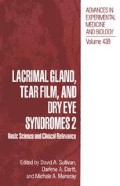Abstract
The normal precorneal tear film usually remains intact between consecutive blinks, but holes begin to appear and grow at random spots in about 10–60 sec when blinking is prevented. Although the exact mechanism of the tear film breakup has eluded our understanding, it is certain that the breakup is secondary to the nonwettability of the corneal surface. We had earlier proposed a mechanism based on the possibility of the rupture and dewetting of the precorneal mucus layer due to the long-range van der Waals forces.1–4 The tear breakup was thought to be triggered by the “hydrophobicity,” or nonwettability, of the underlying corneal epithelial surface devoid of its mucus covering.
Access this chapter
Tax calculation will be finalised at checkout
Purchases are for personal use only
Preview
Unable to display preview. Download preview PDF.
References
Sharma A, Ruckenstein E. Mechanism of tear film breakup and formation of dry spots on cornea. J Colloid Interface Sci. 1985; 106: 12–27.
Sharma A, Ruckenstein E. Mechanism of tear film breakup and its implications for contact lens tolerance. Am J Optom Physiol Opt. 1985; 62: 246–253.
Sharma A, Ruckenstein E. The role of lipid abnormalities, aqueous and mucus deficiencies in the tear film breakup and implications for tear substitutes and contact lens tolerance. J Colloid Interface Sci. 1986; 111: 8–21.
Ruckenstein E, Sharma A. A surface chemical explanation of tear film breakup and its implications. In: Holly FJ, Lamberts DW, MacKeen DL, eds. The Preocular Tear Film in Health, Disease, and Contact Lens Wear. Lubbock, TX: Dry Eye Institute; 1986: 697–727.
Reiter G. Dewetting of thin polymer films. Phys Rev Lett. 1992;68:75–78.
Reiter G. Unstable thin polymer films. Langmuir. 1993; 9: 1344–1351.
Redon C, Brzoska JB, Brochard-Wyart F. Dewetting and slippage of microscopic polymer films. Macromolecules. 1994; 27: 468–471.
Yerushalmi-Rozen R, Klein J, Fetters LJ. Supression of rupture in thin nonwetting liquid films. Science. 1994; 263: 793–795.
Yerushalmi-Rozen R, Klein J. Stabilization of nonwetting thin liquid films on a solid substrate by polymeric additives. Langmuir. 1995; 11: 2806–2814.
Faldi A, Composto R.1, Winey Kl. Unstable polymer layers. Langmuir. 1995; 11: 4855–4861.
Guerra JM, Srinivasarao M, Stein RS. Photon tunneling microscopy of polymeric surfaces. Science. 1993; 262: 1395–1400.
Sharma A, Reiter G. Instability of thin polymer films on coated substrates. J Colloid Interface Sei. 1996; 178: 383–399.
de Gennes PG. OR Acad Sci. 1979; 228B: 219–224.
Brochard-Wyart F; de Gennes PG, Hervert H, Redon C. Wetting and slippage of polymer melts on semi-ideal surfaces. Langmuir. 1994;10:1566–1572.
Sharma A, Khanna R Macromolecules. Nonlinear stability of microscopic polymer films with slippage. 1996; 29: 6959–6961.
Tiffany JM. Measurements of wettability of the corneal epithelium. I particle attachment method. Acta Ophthalmol. 1990;68:175–181.
Tiffany JM. Measurements of wettability of the corneal epithelium. II contact angle method. Acta Ophthalmol. 1990; 68: 182–187.
Sharma A. Surface properties of damaged and normal corneal epithelia. J Dispersion Sci Tech, 1992; 13: 459 - 478.
Sharma A. Energetics of corneal epithelial cell-ocular mucus-tear film interactions. Biophys Chem. 1993; 47: 87–99.
Sharma A. This volume.
Nichols BA, Chiappino ML, Dawson. Demonstration of the mucous layer of the tear film by electron microscopy. Invest Ophthalmol Vis Sci. 1985; 26: 464–473.
Prydal JI, Artal P, Woon H, Campbell FW. Study of human precorneal tear film thickness and structure by interferometry. Invest Ophthalmol Vis Sci. 1992; 33: 2006–2011.
Adams AD. In: Holly FJ, Lamberts DW, MacKeen DL, eds. The Preocular Tear Film in Health, Disease, and Contact Lens Wear. Lubbock, TX: Dry Eye Institute: 1986: 304–311.
Khesgi HS, Scriven LE. Dewetting: nucleation and growth of dry regions. Chem Eng Sci. 1991; 46: 519–525.
Sharma A. Relationship of thin film stability and morphology to macroscopic parameters of wetting in the apolar and polar systems. Langmuir. 1993; 9: 861–869.
Sharma A, Jameel AT. Nonlinear stability, rupture and morphological phase separation of thin fluid films. J Colloid Interface Sci. 1993;161:190–208
Sharma A, Jameel AT. Stability of thin polar films on nonwettable substrates. J Chem Soc Faraday Trans. 1994; 90: 625–628.
Khanna R, Jameel AT, Sharma A. Stability and breakup of thin polar films on coated substrates. Ind Eng Chem Res. 1996; 35: 3081–3092.
van Oss CJ, Chaudhury MK, Good RJ. Interfacial Lifshitz-van der Waals and polar interactions in macroscopic systems. Chem Rev. 1988; 88: 927–941.
van Oss CJ. Acid-base interfacial interactions in aqueous media. Colloids Surf A. 1993; 78: 1–49.
Ruckenstein E, Jain RK. Spontaneous rupture of thin liquid films. J Chem Soc Faraday Trans II. 1974; 70: 132–141.
Sharma A, Kishore CS, Salaniwal S, Ruckenstein E. Nonlinear stability and rupture of ultrathin free films. Phys Fluids A. 1995; 9: 1832–1840.
Holly FJ, Lemp MA. Wettability and wetting of corneal epithelium. Exp Eye Res. 1971; 11: 239–250
Holly FJ, Lemp MA. Formation and rupture of the tear film. Exp Eye Res. 1973; 15: 515–525.
Sharma A, Coles WH. Physico-chemical factors in tear film breakup. ARVO Abstracts. Invest Ophthalmol Vis Sci. 1990; 31: S552.
Sharma A. Perturbation analysis of surface dewetting by formation of holes. J Colloid Interface Sci. 1993; 156: 96–103.
Klatz SA, Au YK, Misra RP. A partial thickness epithelial defect increases the adherence of Pseudomonas aeruginosato the cornea. Invest Ophthalmol Vis Sci. 1989; 30: 1069–1074.
Sokol JL, Masur SK, Asbell PA, Wolosin JM. Layer-by-layer desquamation of corneal epithelium and maturation of tear-facing membranes. Invest Ophthalmol Vis Sci. 1990; 31: 294–304.
Author information
Authors and Affiliations
Editor information
Editors and Affiliations
Rights and permissions
Copyright information
© 1998 Springer Science+Business Media New York
About this chapter
Cite this chapter
Sharma, A. (1998). Breakup and Dewetting of the Corneal Mucus Layer. In: Sullivan, D.A., Dartt, D.A., Meneray, M.A. (eds) Lacrimal Gland, Tear Film, and Dry Eye Syndromes 2. Advances in Experimental Medicine and Biology, vol 438. Springer, Boston, MA. https://doi.org/10.1007/978-1-4615-5359-5_39
Download citation
DOI: https://doi.org/10.1007/978-1-4615-5359-5_39
Publisher Name: Springer, Boston, MA
Print ISBN: 978-1-4613-7445-9
Online ISBN: 978-1-4615-5359-5
eBook Packages: Springer Book Archive

